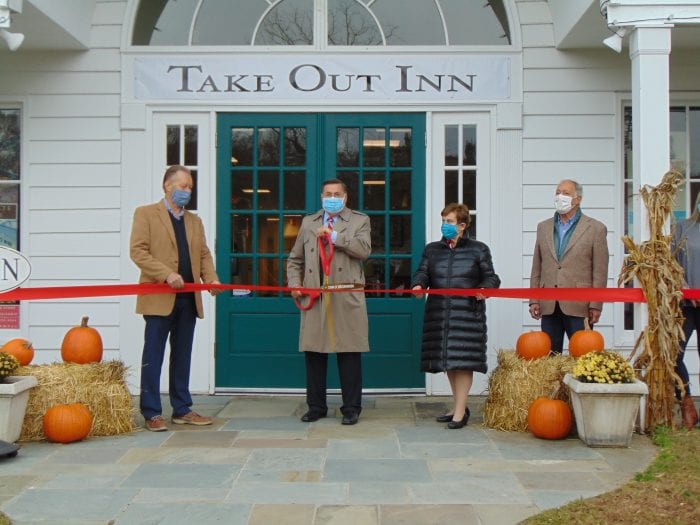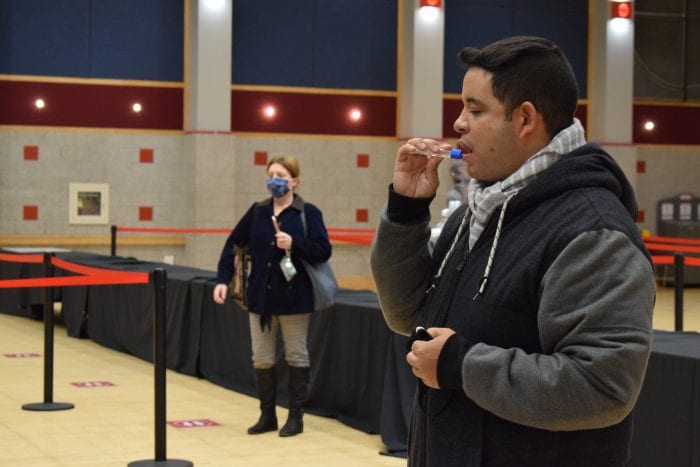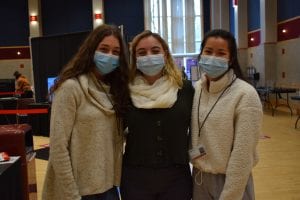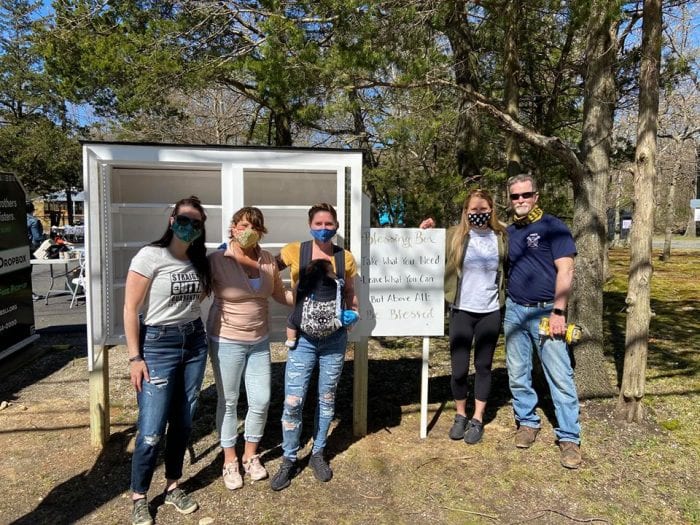Yearly Archives: 2020
Wonderful Ranch In Farmingville!
Stony Brook Village Center Uses Vacant Space for Diners

It’s not exactly the Reese’s Peanut Butter Cup, but it’s a combination that makes sense and hopefully for three restaurants in the Stony Brook Village Center, a few dollars as well.

As the temperatures have dropped, restaurants in the center continue to have limited seating capacity to accommodate the indoor gathering restrictions of the pandemic.
Across from Crazy Beans, Jos. A. Bank had vacated its over-3,000-square-foot men’s clothing store. With help from The Ward Melville Heritage Organization, local officials including Brookhaven Town Supervisor Ed Romaine (R), the storefront has been reborn as a 15-table, 15-chair dining area called the Take Out Inn.
The site will allow people who are shopping or visiting the village to order food from three nearby restaurants and sit in socially distanced tables from 10 a.m. to 4 p.m. on Monday to Friday and from 9 a.m. to 4 p.m. on Saturday and Sunday.
“The objective is for them to be able to survive during the winter months and this is an opportunity to do that,” said Gloria Rocchio, president of SBVC.
She said the idea of using empty space to help businesses that need it “just makes sense.”
Customers inside the inn can access touchless menus by using QR codes for Crazy Beans, Robinson’s Tea Room and Pentimento Restaurant. They can order their food and eat inside the heated facility.
After a ribbon-cutting ceremony with Romaine on Tuesday, Rocchio, who is also the president of WMHO, spoke with two women who wandered into the new space.
Rocchio said they were from Great Neck and Oyster Bay and planned to eat at the new dining space the next day, which is what the new effort made possible.
Romaine said many local businesses have had a tough time surviving during the pandemic. The town is willing to work with civic groups and chambers of commerce to use empty lots in the same way WMHO, which operates the village center, has done with the Take Out Inn.
The town has no fee for setting up such an arrangement.
“Even if it can’t be exactly replicated, it’s going to get the other business leaders thinking about other creative ways we can address the issue, so they can stay in business, make a living and feed their families,” Romaine said.
The town supervisor said any similar ideas or opportunities to keep businesses afloat amid COVID restrictions would be expedited, going to the “top of the pile.”
“We’re talking about the economic survival of people who are having a great deal of difficulty making a living and staying in business,” Romaine said. “If we lose our restaurants, we start losing our downtowns and our sense of community.”
The site, which has sanitizing stations, uses ionization generators which are attached to the ductwork for the heating and air conditions. When the climate control system is on, the air passes through a system that kills mold, bacteria and viruses.
“We did the best we could to keep it as clean and sanitized as possible,” Rocchio said.
Romaine said he would be happy to go to the Take Out Inn if he’s catching a quick lunch or a sit-down dinner.
The inn has a sign that encourages people to relax, enjoy but don’t linger, as WMHO would like to provide a place for people to rest and eat. The facility complies with Centers for Disease Control and Prevention rules and follows all New York State guidelines.
The town supervisor hopes other facilities consider everything they can to stay in business.
One of the challenges in trying to come up with business solutions is the renewed threat from a virus that has returned to the area, causing hundreds of new infections and threatening new restrictions.
Romaine will be going over this approach, as well as other ideas with a business recovery task force.
When he presents this approach, he said he will explain, “This is what The Ward Melville Heritage Organization did.” He added, “If you have any ideas, please, let’s discuss it,” either at the task force or by calling the town supervisor.
Charming Home In Port Jeff Village!
Bellone Urges Caution on Thanksgiving Eve
On the night before Thanksgiving, high school and college students typically come together to reconnect, share stories and share a drink.
This year, as COVID-19 cases climb throughout the U.S., including in Suffolk County, County Executive Steve Bellone (D), along with the Suffolk County Police Department and local enforcement offices, are discouraging gatherings that might cause further spread of the virus.
Enforcement efforts will using social host laws, which fine residents for allowing underage drinking, and state-mandated gathering restrictions, which combined, could lead to “serious consequences,” Bellone said on a conference call with reporters Nov. 17.
“No matter where you are or what you are doing, social distancing and mask guidelines must be followed,” Bellone said. “We’ve come too far to go back now.”
With new state restrictions that limit the sale of alcohol after 10 p.m. through bars and restaurants, Bellone said enforcement efforts would be on the look out for gatherings at private residences. Some of these viral spreading events have occurred during smaller gatherings.
“The spread of COVID-19 at these types of parties is very, very real,” Bellone said. “We’ve seen it countless times. We all need to take personal responsibility,” which includes parents who need to comply with social host laws and the state’s gathering limits in homes.
Bellone announced a partnership between the Suffolk County Department of Health and the nonprofit Partners in Prevention, which is starting a social media campaign to inform the community about social host laws. Bellone called this information “critical” leading up to Thanksgiving celebrations.
While Suffolk County enforcement efforts will respond to calls about larger group gatherings, Bellone said police would use “common sense” and would not be “going door to door to check on the number of individuals in a house.”
As for the infection rates, the numbers continue to rise, returning to levels not seen in months.
“We expect our numbers [of positive tests] to be around 400 today,” Bellone said. The positivity rate is about 3.4 percent, while the number of people hospitalized with symptoms related to the virus approaching 100.
“We have not been above 100 since June 18,” Bellone said. In the last 24 hours, the number of people who have required hospitalization from the virus increased by 16.
While the virus has exhausted people physically and mentally, the county cannot “jeopardize our continued economic recovery” and the health of the population by stepping back from measures such as social distancing, mask wearing and hand washing that proved so effective in reducing the spread earlier this year, Bellone said.
“Now is the time to double down on common sense measures that work,” he added.
Some of the positive tests are coming from people in nursing homes, who are among the most vulnerable population.
“With the nursing homes, that is obviously a big concern,” Bellone said. The county is “making sure they have the PPE [personal protective equipment] they need.”
The Department of Health is staying in close contact with these facilities as cases continue to climb.
Bellone urged residents who dined at a Friendly’s restaurant in Riverhead on Nov. 5 or 6 to monitor their symptoms for the next two weeks. Six adults who worked at the restaurant have tested positive for the virus.
Anyone who is exhibiting symptoms of the virus, which include fever, a runny nose, lost of taste or smell, fatigue, shortness of breath, can find a testing site at suffolkcountyny.gov/covid19.
Separately, when asked about the possibility of schools closing in response to the increasing incidence of positive tests, Bellone urged schools to remain open at this testing level.
Stony Brook Offers COVID-19 Testing for Thanksgiving Break

Stony Brook students and faculty have been utilizing the campus’ quick, free saliva swab testing to stay clear of the Coronavirus before holiday break.

Although students will not be returning to campus after the Thanksgiving holiday, the university began implementing swab testing sites on three parts of campus for commuter students, residents and faculty.
Earlier this month, Marisa Bisiani, assistant vice president for student health, wellness, and prevention services issued a message to students concerning COVID testing and the Thanksgiving holiday.
“We are committed to maintaining the health and safety of our campus community,” she said. “This includes requiring COVID testing for students who, like you, live off-campus, but may come to campus for an in-person class, work on campus or visit campus facilities.”
In accordance with SUNY policy, all commuter students must complete a COVID test within the 10-day period prior to the start of the break.
“As many COVID cases are asymptomatic, meaning you can be infected, and unknowingly and unintentionally spread the disease to others, we want you to know your health status before Thanksgiving to help keep you and your family safe,” she added.
Faculty and students who are on campus from Nov. 9 through Nov. 20 must get tested. If a student will not be on campus at that time, they must fill out an exemption form online.
After scheduling an appointment online, students are able to visit the Student Activity Center, the Health Sciences Center Galleria and for East End students, at the Stony Brook Southampton campus’ student center. There they receive a mouth swab and safely hand it over to the workers for testing. Results come back two to five days after the swab.
“We get over 150 tests done a day,” said Elah Ginsberg, a sophomore on campus who works at the testing site. “Yesterday we have 300 come by.”
The need for quick testing on campus began early last month, with new requirements that faculty, staff and commuter students to get checked for the virus.
“All commuters have to get their cheeks swabbed,” Emily Lam, a senior volunteer at the site, said. “I think it’s way safer and ensures that they’re healthy when they come to campus.”
Patricia Indelicato, health administration coordinator on campus, said she loves that this opportunity is so easily available. “It’s great and it’s helping to keep the community safe.”
Lauren Crennan, who works at the university’s undergraduate college, said that although it’s required for her to get tested, she doesn’t mind doing it one bit.
“I’m happy that they’re doing it,” she said. “It gives me a peace of mind and it’s an easy two-minute walk from my office.”
With New Health Rules, Some Pediatric Illnesses Decline

The school and day care mixing bowl of bacterial and viral illnesses has changed. As schools, day-care centers, clubs, sports teams and other organizations change the way they manage group gatherings amid the pandemic, the game of illness tag children seem to play has slowed.
“We are seeing potentially less viral illnesses thus far in the sense that we have not seen an increase yet in respiratory syncytial virus, or RSV,” said Christy Beneri, Associate Professor of Pediatrics and Program Director of Pediatric Infectious Diseases at Stony Brook Children’s Hospital. “We are still waiting to see what happens with the flu.”
The chance of children contracting some of those illnesses would likely be less this year amid the infection control measures to reduce the spread of COVID-19, the disease responsible for the pandemic.
Beneri said children are getting somewhat fewer infections, although doctors are still seeing strep throat, ear infections and pneumonia.
Viral-induced asthma visits have declined at Stony Brook. Children who have asthma are still seeking medical attention, particularly if their condition doesn’t have a viral trigger.
At the same time, the effects of social isolation, uncertainty about the future, and household anxiety has triggered an additional mental health burden, particularly for adolescents.
Pediatricians are “asking patients more about those issues,” she said. “We maybe didn’t ask as much as we should have in the past.”
Even though children generally have less contact with their contemporaries this year, they are still developing illnesses, as their immune system receives challenges from microbes through dirt, pet saliva and other sources.
The dynamic is “slightly different in terms of getting some of these viruses from other people, [but] there are still pathogens in their environment,” she said.
In the current environment, with positive tests for COVID-19 setting new national daily records, Beneri said it is important to practice infection control measures in certain settings, which will impact what children are exposed to over time.
The cultural shift from sending children who might have mild symptoms to school to keeping children home for the good of their fellow students and staff has helped reduce the spread of COVID and other potential infections.
“We’ve taken a step back from what makes sense not just for my child, but for others my child might be exposing,” Beneri said. The decision about whether to send a child who might be battling an illness, cold or minor discomfort to school “is not just about us. It’s about those in our communities and, hopefully, there’s a better recognition” about the impact an infected child can have.
Some of the infection control measures, such as hand hygiene and staying home when children are sick should continue even after companies start providing a COVID-19 vaccine.
At this point, with the virus still prevalent in the community and country, she said acute care visits are declining, as parents are managing at home and are watching and waiting to see how their children recover from any infection.
As a parent, Beneri is dealing with the disappointment and disruption of life in the pandemic for her seven-year-old daughter. Twice, the family has had to cancel a trip to Disney World and has scheduled it for a third time.
Once the worst of the pandemic passes and children get back together again, the pediatric program director said there might be an increase in certain infections, but that doesn’t necessarily mean the county will see horrific outbreaks.
With the approach of Thanksgiving and the December holidays, Beneri urges families to be creative about gatherings. She suggested that smaller groups might want to get together over two weekends, rather than all gathering at the same time.
As for advice to schools, Beneri urges people to remain mindful of their activities outside of school.
“It’d be a shame to have to close schools,” Beneri said.
Beneri added people can celebrate milestones like turning 16, but they should not have a 40-person event in the current environment.
Rina Christy, Comsewogue Alumna and Champion for Women and Environment, Dies at 53
Celerina Maureen Miguel Cristy, age 53, died April 15 this year of respiratory heart failure resulting from infection by COVID-19. She died at Richmond University Medical Center, Staten Island. Friends called her Rina.
Rina, who grew up in Port Jefferson Station, had a career that intersected with national events in politics and developing the economy, particularly by enhancing global financial security after the 2001 terrorist attacks on the United States.

Rina and her husband of 23 years, Sam Cristy, were parenting two teenage children at the time of her death. The Cristys have lived in Staten Island since 2004. Rina had lived or worked in Port Jefferson Station, Boston, metro Washington, D.C., Manhattan and Jersey City.
Born in November 1966 in Chicago, Rina was the first of her family born in the U.S. Her parents, Art and Gloria Miguel, immigrated from the Philippines, then met and married in America. Art was an engineer in aviation, and Gloria was a nurse. The Miguels moved to Port Jefferson Station, where they still live. The gregarious household grew to include Rina’s two younger brothers and two grandparents. Later, the Miguel home expanded again to incorporate Rina and Sam, and soon thereafter a grandson. Four generations gathered daily for breakfast.
Rina is a Comsewogue High School alumna. She attended Emerson College in Boston, graduating in 1988 with a Bachelor of Science in speech communications, advertising, and public relations. In 2000, she received her Master of Business Administration degree in computer information systems from Hofstra University, where she earned the prestigious Hofstra University MBA Fellowship.
Community service is an innate Miguel family hallmark. Rina’s grandfather was an educator and a decorated officer of U.S. and Philippine armies. Rina described her mother as the springboard to political engagement and developing a New Yorker ethos. Rina recalled co-piloting a plane with her father, Art. Such moments inspired her to imagine boundless agency, Rina said. Thus prepared, she moved from Boston to Washington, D.C., to start her career in 1988.
Rina served the Honorable U.S. Rep. George Hochbrueckner (1-NY), Eastern Long Island, administering finance and fundraising in his congressional campaigns. She joined the congressional staff and quickly advanced to senior legislative aide. Reflecting on Rina’s accomplishments, Hochbrueckner commented, “Rina’s diligent activities aided in the funding of the initial as well as the ongoing dredging of Shinnecock Inlet, thus preventing the loss of lives of the local commercial fishermen. She also assisted in the designation of Peconic Bay as a new member of the National Estuary Program, providing special environmental funding to this day.” Her collaboration also secured federal funds for Lyme disease mitigation and education.
Following her congressional work, Rina proceeded to the Defenders of Wildlife conservation society. As aide to the director, she served the executive board and contributed to the conservation of wild lands and restoration of wolf habitats.
The 1990s on Capitol Hill invigorated Rina’s optimism that she could make an enduring contribution in the nexus of public policy and business. The Calverton Enterprise Park is an example. Rina facilitated the legislative steps that converted the federal aviation site to ownership by the Town of Riverhead. This pivot from Cold War defense projects opened the way for emerging environmental health sciences. Calverton now stands primed to open temporary hospital services during the COVID pandemic.
Rina’s pivot to finance came via her Hofstra MBA. She was subsequently hired by the Federal Reserve Bank in Manhattan. There, she supported the U.S. Federal Reserve System’s function in regulating and examining regional and global banks. Her work protected deposits, assessed bank solvency, and engaged protections against money laundering and terrorist financing.
Starting in 2004, Rina developed her specialty as an executive in retail and wholesale banks developing data, personnel, and operations systems for transaction security and compliance with regulations and best practices.
She worked in the Staten Island offices of Independence Community Bank. She proceeded to Rabobank International and ultimately to Sumitomo Mitsui Banking Corporation in Manhattan, where she rose to Director & Group Manager of Compliance Operations before being assigned as Director of Compliance Department, Americas Division.
In the era following the 2001 terrorist attacks, bankers wrestled with costly and demanding federal laws for enhanced fiduciary obligations. Evaluating competition, profits, and best practices called for a newly specialized banker. Banks were tasked to ask clients prickly questions, slow deals, and (perhaps) defer legitimate loans until novel risk assessments were satisfied. The urgent world of finance strained to adopt these subjective analyses. As banks with problems incurred fines, compliance experts like Rina proved essential to keeping banks in good control.
Rina’s policy and bank experience fit this role. Her teams set out to divine regulatory expectations and move banks to comply. Foremost, she assured profit drivers that the evolving security measures were intrinsic to bank success. Rina was gratified to see her early interpretations as an auditor at the Fed gain adoption as trade standards years later.
One of Rina’s work colleagues, Risë Zaiser, bonded with Rina as mentor and friend. They shared triumphs in motherhood and careers. Zaiser tracked Rina’s moves in various banks and trade panels.
“When we first met her, she came in guns a-blazing, and we were talking about how we were going to get her a bat. But she didn’t need a bat. She was just able to convince, and they followed her direction,” Zaiser said.
Industry colleagues noted that Rina was an effective department director because of her genuine humanity, humor, and collaboration. Life in banking cubicles can be fraught, staid, and tedious. One boss recalled surprise, then gratitude in receiving an office hug.
“Smiles can tear down the tallest, thickest walls. The power of Rina’s smile was the selflessness behind it,” he said. “Rina was always positive and upbeat, addressing adversity with that smile. I challenge all of us to take what Rina has given us and pass it along.”
Rina was passionate about cultivating professional opportunities for women and developing diversity in business and civic leadership. Hofstra invited her to speak quarterly to business students, and she regularly trained interns. SMBC designated a scholarship in Rina’s name to enhance the Women’s Inclusion Network professional development project. SMBC noted her continuous mentoring of students and professionals.
“That enthusiasm and willingness to take on things widened her scope,” Zaiser noted. In the Women’s Inclusion Network, Rina was a “tireless devotee,” and she answered a call to be a co-president. “We all voted for her. It was great to work with her. I’m really going to miss her joyfulness.”
Rina was a devoted member of Brighton Heights Reformed Church in St. George. She joined the denomination as a long-time member of the Reformed Church of America at Stony Brook, previously known as Christ Community Church.
Staten Islanders knew Rina as a passionate supporter of families at Dance Dance Dance, Ltd., where her daughter thrived as a student. Many knew Rina through her masterful knitting, which she shared lovingly with cancer patients, premature babies and many friends.
She loved ballroom dancing with Sam. She engaged her kids’ every pursuit with verve, including raising a rescue pitbull. From Rina, her children learned faith in God, the enduring affection of family, and how to cook from scratch.
When Rina contracted COVID, the disease was daily killing 2,000 in the U.S., 8,000 people worldwide. To her family, she endures in death as a true a love and steadfast guide. Quarantined, short of breath, and resolute, she typed her gratitude to the world: “Be kind to each other.”
Rina is survived by her husband, Sam; their children, Alex and Amelia, of Staten Island; parents, Art and Gloria Miguel; brother Arturo Miguel, his wife Kim, and nephew Gabriel; and brother Fernando Miguel, his wife Kim, and nephews Colin, Elias, and Reece.
A family memorial service will be recorded and broadcast on YouTube at 3p.m. Saturday, Nov. 21. Matthew Funeral Home, Staten Island, arranged the cremation. In lieu of flowers, the family suggests donations to ameliorate effects of the pandemic.
The funeral home and Rina’s Facebook page will post updates about observances, including congregational observances in future months at Brighton Heights Reformed Church, Staten Island. To view the memorial, use these links:
Main link: https://youtu.be/7jQKsQzd1r4
Backup link: https://youtu.be/UHYVv2152-c
Video of SWR Teens Using Racist Slurs Goes Viral, Superintendent Denounces “Reprehensible” Student Actions
A video of two Shoreham-Wading River students using racial slurs and making racially derogatory comments on social media has led to significant backlash online and from district leaders.

The video in question was on a platform called Omegle, which pairs random people for video chat. That interaction was then published to other social media apps TikTok and Twitter Nov. 10.
The video shows two unidentified young men, who have been named students in the Shoreham-Wading River school district, paired on the social media platform with a man named Jovan Bradley, who according to his Twitter profile lives in Poughkeepsie. Bradley started off the conversation with a greeting, then the young men started with “My N*****” and “What’s up, N****.” The video continues with one of the two young men calling Bradley “slave” and saying, “I’m going to whip you” and mimicking cracking a whip.
Bradley, who is mixed race, later posted a video of the interaction to Twitter and TikTok. In it, he repeatedly asked the young men, “Why?” The Twitter video has been viewed over 38,000 times. The TikTok video has been seen over 417,000 times as of Nov.16.
The names of the two young men have not been released or could not be independently confirmed by press time. People on social media went on trying to find the names of the two students, but some supposed names of the two young men involved have been mistaken for other social media profiles.
Superintendent of Schools Gerard Poole released a statement Nov. 12 saying the video was “reprehensible” and that it was “in clear violation of the core values of our school district.” Poole said the matter will be addressed with both students for further disciplinary action.
The superintendent added that the district is rooted in teachings of “tolerance, acceptance and the importance of embracing diversity,” and they have tried to “cultivate a sense of unity and inclusion in our school community.”
Like many North Shore school districts, Shoreham-Wading River is predominantly white. The district is 87% white, 1% Black, 8% Hispanic or Latino and 2% Asian, according to New York State Education Department data. Long Island has a long history of de facto segregation, and advocates most commonly express this discrepancy by comparing districts like those on the North Shore with places like Brentwood, which is predominately Black and Latino.
Bradley posted to Twitter that at least one parent had contacted him with an apology by one of the students. The other student has yet to send an apology, according to the Poughkeepsie man’s latest TikTok post. Bradley has posted that he has gone on Omegle to debate people and also publicly shared his response to the apology Nov. 13, saying he hopes the young man takes “positive things from this experience” and that he hopes the young man sees fault with his actions “at a human level.”
“Take this experience to continue to educate yourself on what has and is happening in our country,” Bradley said in his post. “I do wish you a bright future if you can make those changes. Everyone deserves a second chance.”
Nonprofits Offer More Help for Youth Mental Health

It’s been a stressful time.
In the age of COVID-19, more and more organizations are attempting to adapt to the influx of people needing mental health.
Last month, Steve Chassman, executive director of the Long Island Council on Alcoholism and Drug Dependence, said in a press conference in September regarding potential Suffolk healthcare cuts that substance abuse has skyrocketed because of the coronavirus crisis. “We have propelled to where we were six months ago,” he said at the time.
And that’s why the Sunshine Prevention Center in Port Jefferson Station is here to help. Carol Carter, CEO/co-founder of the community youth and family agency that offers support and education in the areas of drug/alcohol prevention, socials skills, leadership and alternative education, said in the age of COVID, they had to adapt to help more people.
“When COVID-19 first hit, we really scrambled,” she said. “We worked really hard to build a reputation in the community for still providing services.”
The center quickly learned how to Zoom and create Facebook Live and YouTube videos for kids and families to watch at home.
“We had close to a thousand people watching them,” she said.
According to Carter, the group learned that the rate of anxiety and depression was getting higher at the start of the pandemic, and domestic violence increased to at least by 20%. She and her organization knew how important it was to help people during such a trying time.
“We would drop off [worksheets/exercises] to homes,” she said. “We tried not get so caught up in the fear, but we wanted to be there to help them.”
As the pandemic evolved, so did their online learning. Carter began writing daily, weekly and then monthly newsletters. “They would have resources and positive messages for the day,” she said. “We’d mention other programs that were running. … We tried to stay connected that way.”
The center began to Zoom meetings for kids, young adults and parents at night, but more recently in September, they began socially distanced in-person adult groups again.
“We started in-person because of the demand,” she said. “They need more of the social interaction. … We’ve been told ‘thank you.’ We tried to get back to some type of normalcy. Although people are still afraid, they’re grateful.”
But along with the substance abuse problem as described by Chassman, everyone is feeling more anxious than before.
Further east at the North Shore Youth Council in Rocky Point, Dana Ellis, director of mental health and wellness programming, said she has seen a dramatic increase in anxiety among young adults.
“Anxiety is the biggest thing I’m seeing more so compared to last year,” she said. “The amount of kids and interests approaching doubled. … A lot more people are looking for help and support during this time.”
Before COVID-19, her group would work with Rocky Point school district to help students with their mentoring program. This year, however, they were unable to meet because clubs were canceled.
“My biggest thing is giving kids opportunities to socialize, meet people, talk with each other and recognize things will be OK,” she said. “Our goal is to increase mental health programing in general.”
The youth council also decided recently to restart in-person group meetings, because they know how important it is for young adults to talk about how they’re feeling. Upon arrival, they give temperature checks, must wear masks and have the option to Zoom in, if they choose.
“I’ve definitely started off my groups with coping skills,” Ellis said. “I started treating them like stressless groups because more than ever kids are stressed, and I’m trying to make that the forefront of the groups that I run.”
In those groups, people talk about the worries they face in day-to-day life. ““I think that’s from a variety of things,” she said. “In general, it’s a very stressful time we’re living in.”










